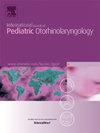The efficacy of auto-inflation in children with chronic otitis media with effusion
IF 1.2
4区 医学
Q3 OTORHINOLARYNGOLOGY
International journal of pediatric otorhinolaryngology
Pub Date : 2025-05-21
DOI:10.1016/j.ijporl.2025.112403
引用次数: 0
Abstract
Objective
To explore the efficacy of auto-inflation in children with chronic otitis media with effusion.
Method
Clinical data of 81 children (157 ears) with chronic otitis media with effusion treated in our hospital from December 2023 to November 2024 were collected. There are 37 males and 44 females, aged between 3.67 and 14.42 years old, with an average of 7.37 ± 2.68 years old. 71 cases complained of otalgia, 8 cases of hearing loss, 1 case of ear fullness, and 1 case of recurrent otitis media after grommet insertion. All patients underwent 3 months of conservative treatment.
Result
The changes in hearing thresholds before and after auto-inflation exhibited distinct frequency-specific characteristics, with the lowest hearing loss observed at 2000 Hz, which was significantly lower than that at 1000 Hz and 4000 Hz (P < 0.05, statistically significant difference). The pure-tone audiometry of pre-treatment evaluation (P-TE) was 26.61 ± 11.553 dB. At 2 weeks, 4 weeks, 8 weeks, 12 weeks, and termination of treatment, the pure-tone audiometry were 15.63 ± 10.308, 14.37 ± 5.508, 16.62 ± 13.273, 12.11 ± 7.315, 13.82 ± 8.520 dB, respectively. Compared with P-TE, the difference was statistically significant (P < 0.05). The P-value was <0.05, indicating statistically significant differences. For P-TE, 78.344 % (123/157) of patients exhibited a Type B tympanogram. At 2 weeks, 4 weeks, 8 weeks, 12 weeks, and at the terminating evaluation (TE), the proportions were 22.472 % (20/89), 21.533 % (14/65), 14.815 % (8/54), 3.448 % (1/20), and 11.765 % (18/153), respectively. Compared with P-TE, the difference was statistically significant (P < 0.05). After 12 weeks of standardized treatment, 22.93 % (36/157) of otitis media cases achieved complete resolution, 74.52 % (117/157) showed clinical improvement, and 2.55 % (4/157) had no therapeutic response. Otalgia was the only adverse reaction (3.7 %, 3/81) and can be relieved.
Conclusions
Auto-inflation is effective in children with COME, with rapid results and minimal adverse reactions.
慢性中耳炎伴积液患儿自体充血的疗效观察
目的探讨自体充气治疗儿童慢性中耳炎积液的疗效。方法收集我院2023年12月至2024年11月收治的慢性中耳炎伴积液患儿81例(157耳)的临床资料。男性37例,女性44例,年龄3.67 ~ 14.42岁,平均(7.37±2.68)岁。其中耳痛71例,听力下降8例,耳充盈1例,植入耳套后复发中耳炎1例。所有患者均接受了3个月的保守治疗。结果自充气前后的听力阈值变化具有明显的频率特异性,2000 Hz时听力损失最低,明显低于1000 Hz和4000 Hz (P <;0.05,差异有统计学意义)。预处理评价纯音听力学(P-TE)为26.61±11.553 dB。治疗第2周、第4周、第8周、第12周及治疗结束时,纯音听力分别为15.63±10.308、14.37±5.508、16.62±13.273、12.11±7.315、13.82±8.520 dB。与P- te比较,差异有统计学意义(P <;0.05)。p值为<;0.05,差异有统计学意义。对于P-TE, 78.344%(123/157)的患者表现为B型鼓室图。在2周、4周、8周、12周和终止评估(TE)时,比例分别为22.472%(20/89)、21.533%(14/65)、14.815%(8/54)、3.448%(1/20)和11.765%(18/153)。与P- te比较,差异有统计学意义(P <;0.05)。经过12周的规范化治疗,22.93%(36/157)的中耳炎患者完全缓解,74.52%(117/157)的中耳炎患者临床好转,2.55%(4/157)的中耳炎患者无治疗反应。唯一不良反应为牙痛(3.7%,3/81),可缓解。结论sauto -inflation治疗儿童COME疗效好,见效快,不良反应少。
本文章由计算机程序翻译,如有差异,请以英文原文为准。
求助全文
约1分钟内获得全文
求助全文
来源期刊
CiteScore
3.20
自引率
6.70%
发文量
276
审稿时长
62 days
期刊介绍:
The purpose of the International Journal of Pediatric Otorhinolaryngology is to concentrate and disseminate information concerning prevention, cure and care of otorhinolaryngological disorders in infants and children due to developmental, degenerative, infectious, neoplastic, traumatic, social, psychiatric and economic causes. The Journal provides a medium for clinical and basic contributions in all of the areas of pediatric otorhinolaryngology. This includes medical and surgical otology, bronchoesophagology, laryngology, rhinology, diseases of the head and neck, and disorders of communication, including voice, speech and language disorders.

 求助内容:
求助内容: 应助结果提醒方式:
应助结果提醒方式:


